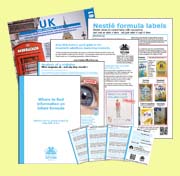Tackling hunger - don't partner food giants, or forget breastfeeding and the underlying causes
Sunday 12th August 2012 - World Leader Summit on hunger - hosted by David Cameron
Tackling hunger - don't partner food giants, or forget breastfeeding and the underlying causes
Baby Milk Action welcomes the Prime Minister's call to address hunger - however we are concerned that part of the call will promote partnerships with the commercial companies who systematically undermine child health.
There are many underlying factors that exacerbate food shortages and hunger - but when partnerships with commercial companies (and bodies that they set up) are promoted as the best solution there are many risks. The control of marketing practices that undermine breastfeeding and sustainable, affordable, nutritious family foods are often overlooked in favour of market-led strategies promoting processed foods that are often unaffordable and inappropriate. (see Business of Malnutrition breaking down trade rules to profit from the poor)
If policy makers are serious about finding long term sustainabile solutions its essential that they address conflicts of interest and protect the health policy planning and implementation process from undue influence from commercial companies and regulate and monitor marketing practices (by implementing the International Code of Marketing of Breastmilk Substitutes and subsequent WHA Resolutions and WHO's Recommendations on Marketing to children)
Policy makers must also, of course, tackle sanitation, water and maternity protection, and acknowledge the inter-related nature between nutrition, the right to food and health and sustainable livelihoods and economies and the root causes of poor nutrition of women, such as structural violence, inequality and discrimination.
Since today's conference will focus on stunting - its worth remembering that stunting is caused by sub-optimal nutrition during pregnancy and feeding in the first two years of life. Diarrhoea during infancy is a significant factor. WHO has documented the link between stunting, diarrhoea and lack of optimal breastfeeding especially during the first six months. Good complementary feeding has also been recognised to significantly reduce stunting. “Diarrhoea often leads to stunting in children due to its association with poor nutrient absorption and appetite loss. The risk of stunting in young children has been shown to increase significantly with each episode of diarrhoea and diarrhea control, particularly in the first six months of life, may help to reduce stunting prevalence among children.”
Page down to find the references on stunting and cord clamping and click here for IBFAN comments on WHO Action Plan on maternal, infant and young child nutrition.
Why protect breastfeeding? There is no food more locally produced or sustainable than breastmilk. One-fifth of deaths among children less than five years could be prevented through optimal infant and young child feeding[1] A breastfed child is less likely to suffer from gastroenteritis, respiratory and ear infections, diabetes, allergies and other illnesses. In areas with unsafe water a bottle-fed child is up to 25 times more likely to die as a result of diarrhoea. Reversing the decline in breastfeeding could save 1.5 million lives around the world every year. Breastfeeding helps fulfill the UN Millennium Development Goals and has the potential to reduce under-5 mortality by 13%. A further 6% of deaths could be saved through appropriate complementary feeding. Breastfeeding also provides health benefits to the mother, such as reduced risk of some cancers.
____________________________________________________________________________________________
I attended Save the Children's week-long workshop on Infant and Young Child Feeding in Emergencies at the end of June alongside 68 nutritionists and health workers from 22 countries. All agreed that collective action is needed to ensure protection and promotion of optimal infant and young child feeding, as a cornerstone of emergency preparedness and response, as well as the bedrock of development nutrition programmes.
In emergency situations infants and young children are at greater risk[2] [3] [4], for example, in Botswana in 2005/6 infants who were not breastfed were 50 times more likely to need hospital treatment, and much more likely to die[5]. Appropriate IYCF-E programming that actively supports optimal IYCF and care of non-breastfed infants according to international guidelines[6] saves lives. Further children who are fed well in infancy are not only more likely to survive but also to reach their physical and cognitive potential. It is also important to recognise that a failure to address IYCF needs both during and outside of emergencies will derail initiatives and efforts to reduce chronic undernutrition.
[1] Jones, Gareth, et al., ‘How many child deaths can we prevent this year?’ The Lancet, vol. 362, no. 9377, 5 July 2003, pp. 65–71.
[2] http://www.ennonline.net/ife/orientation/technical
[3] http://www.ncbi.nlm.nih.gov/pubmed/21426621
[4] WHO. Guiding Principles for Infant and Young Child feeding during Emergencies. 2004
[5] Creek T, ArveloW, Kim A, Lu L, Bowen A, Finkbeiner T, Zaks L, Masunge J, Shaffer N and Davis M. Role of infant feeding and HIV in a severe outbreak of diarrhea and malnutrition among young children, Botswana, 2006. Session 137 Poster Abstracts, Conference on Retroviruses and Opportunistic Infections, Los Angeles, 25-28 February, 2007. http://www.retroconference.org/2007/Abstracts/29305.htm
[6] IFE Core Group. Operational Guidance on Infant and Young Child Feeding in Emergencies. v2.1, Feb. 2007. This document is endorsed by WHA: Resolution 63.23 (May, 2010)
I also attended the World Public Health Nutrition conference in Rio de Janeiro, Brazil in April 2012. This important confernce included a meeing on the Scaling up Nutrition initiative (SUN). The attached notes prepared by the UN Standing Committee on Nutrition give some flavour of the many concerns raised about the SUN process and the calls for it to develop adequate Principles of Engagement with the Private Sector. Currently SUN encourages governments to 'partner' companies - including companies who systematically violate the International Code of Marketing of Breastmilk Substitutes and Resolutions - including the latest WHA Resolution 65.6 - and the WHO Guidelines on Marketing to Children.
Follow these links to see more about IBFAN's concerns about the market-led approaches that are promoted whe Governments enter public private partnerships.
Update 44: http://info.babymilkaction.org/update/update44page16
WHO Executive Board meeting http://info.babymilkaction.org/node/522
World Health Assembly May 2012 http://info.babymilkaction.org/IYCNResolution2012
NGO Comments on the WHO consultation on partnerships http://info.babymilkaction.org/partnershipconsultation
http://info.babymilkaction.org/sites/info.babymilkaction.org/files/IBFAN%20response%20NCDFINAL.pdf
IBFAN Comment on WHO's Action Plan on Infant and Young Child Nutrition.
References on Stunting and cord clamping.
1 Diarrhoea: Why children are still dying and what can be done 2009? UNICEF/WHO
2 Maternal and Child Undernutrition 3 What works? Interventions for maternal and child undernutrition and survival, Bhutta et al. Lancet 2008
3 Checkley, W., et al., ‘Effects of Acute Diarrhea on Linear Growth in Peruvian Children’, American Journal of
Epidemiology, vol. 157, no. 2, 2003, pp. 166-175.
4 Effect of delayed versus early umbilical cord clamping on neonatal outcomes and iron status. Andersson O et al BMJ 2011; 343:d7157 (open access article) and Cochrane Database Syst Rev. 2008 Apr 16;(2):CD004074. Effect of timing of umbilical cord clamping of term infants on maternal and neonatal outcomes. McDonald SJ, Middleton P)
5 The effect of early initiation of breast feeding on the amount of vaginal blood loss during the fourth stage of labor. Sobhy
SI, Mohame NA, J Egypt Public Health Assoc. 2004; 79(1-2):1-12).
- Login to post comments






